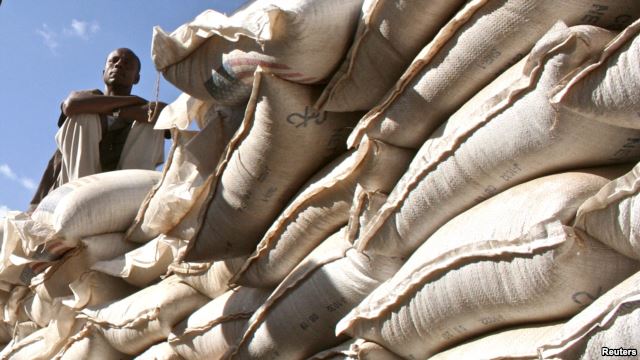 FILE - An unidentified government official sits on sacks of wheat donated by the U.S. at a food distribution point near Jijiga, eastern Ethiopia, Dec. 1, 2009. (Photo: Reuters)
FILE - An unidentified government official sits on sacks of wheat donated by the U.S. at a food distribution point near Jijiga, eastern Ethiopia, Dec. 1, 2009. (Photo: Reuters)
By Marthe van der Wolf
ADDIS ABABA, ETHIOPIA — Drought has ruined this year’s harvest for many Ethiopian farmers. In a country where 85 percent of the people are farmers, millions are in need of aid.
The government has purchased nearly 1 million metric tons of wheat at a cost of about $280 million to get through the next three to four months.
Government spokesman Getachew Redda said the government is in control of the crisis, but is also focused on measures that will reduce the impact of future droughts.
“From a strategic point of view,” Redda said, “the government will continue to further enhance its efforts to develop underground water resources and develop irrigation mechanisms which do not have to depend on the varieties of weather.”
Experts believe the reduction in rainfall is due to the El Nino weather phenomenon. While cycles of drought are expected every 10 to 12 years, the frequency of droughts and erratic rainfalls is expected to increase because of global climate change.
Wagayehu Bekele, climate director at Ethiopia’s Agricultural Transformation Agency, said getting better information to farmers so they can adjust their schedules is a priority.
“Farmers have traditional wisdom,” Bekele said. “They know when to sow, they know when to harvest, when to cultivate. But the problem now is that traditional wisdom is not working anymore. The problem is, even if the rain starts early, they don’t start sowing or planting. Why? They say it’s not the normal time to plant.”
Modernizing traditional practices is part of a short-term solution. Wagayehu thinks that focusing on sustainable ways of farming is just as important.
Agriculture makes up almost half of Ethiopia’s gross domestic product. The lack of rain has severely affected the lowlands and livestock.
Araya Asfaw, director of the Horn of Africa Regional Environment Center and Network, said not enough information about the effect of climate change on Africa is available.
“The model for Africa is not as good because we don’t have enough data, meteorological data, to predict what will happen,” Asfaw said. “We need to have more meteorological stations all over the place.”
Drought and hunger have been sensitive topics in Ethiopia since the infamous famine in the early 1980s that killed over 400,000 people. The government says that the current drought has not killed anyone yet, but that about 8 million people need assistance. The United Nations estimates that number will nearly double in the coming months.
—
Related:
How Bad is the Drought in Ethiopia? (IRIN NEWS)
Ethiopia Starts Distribution of Food & Cooking Oil to People in Drought Hit Areas (AP)
Thirty years of talking about famine in Ethiopia – why’s nothing changed? (BBC)
Drought Takes Terrible Toll in Ethiopia (BBC News)
Ethiopia Tries to Avert Another Famine (The Economist)
Worrying aid shortages as malnutrition hits record high in Ethiopia (Reuters)
El Niño Strikes Ethiopia (NY Times Editorial)
Ethiopia, a Nation of Farmers, Strains Under Severe Drought (The New York Times)
Ethiopia’s Government Makes International Appeal for Food Aid After Poor Harvests (AP)
Ethiopian drought threatens growth as cattle die, crops fail (Bloomberg)
Drought Hits Millions in Ethiopia (Radio France International)
Sharp rise in hungry Ethiopians needing aid: UN (AFP)
Ethiopia: Need for Food Aid Surges (Reuters)
The Cause of Ethiopia’s Recurrent Famine: Is it Drought or Authoritarianism? (The Huffington Post)
Join the conversation on Twitter and Facebook.

























